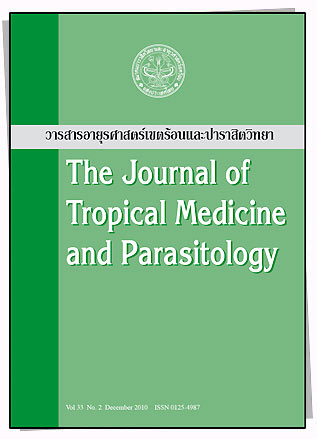Nutritional Status of Schoolchildren with Hookworm Infection in Tha Sala District, Nakhon Si Thammarat Province, Thailand
Main Article Content
Abstract
Abstract
This study aimed to investigate the nutritional status of 214 primary schoolchildren, age 7 to11 years old with moderate and heavy hookworm infection enrolled in a drug trial comparing theefficacy of Nitazoxanide and Albendazole during February-March 2005 in Tha Sala District, Nakhon SiThammarat Province, Thailand. One hundred twety-two schoolchildren (57.0%) had moderate hookworminfection with a mean egg count of 3,878 eggs/gram. Ninety-two schoolchildren (43.0%) had heavyhookworm infection with a mean egg count of 14,347 eggs/gram. Heights and weights were measuredat enrollment. The indices used for nutritional status assessment were weight for age, height for age, andweight for height compared with the reference criteria for Thai children. 22.1% of schoolchildren withmoderate hookworm infestation were underweight, 73% had normal weight and 4.9% were overweight.30.3% of these children had a below average height, 66.4% had a normal height and 3.3% had an aboveaverage height. When evaluating weight for height, 9% were below average 85.2% were normal and 5.7%were above average. In schoolchildren with a heavy hookworm infection, 29.3% were underweight, 69.6%had a normal weight and 1.1% were overweight. 39.1% of these children had a below average height,59.8% had a normal height and 1.1% had an above average height. When evaluating weight for height,13% were below normal, 82.6% were normal and 4% were above normal. One-third of schoolchildrenwith moderate to heavy hookworm infestation were shorter than average for their age. This may reflectlong term nutritional deficiency due to parasitic infestation leading to stunted growth. Yearly stoolexaminations, appropriate anti-helminthic treatment and nutritional supplementation are recommendedto improve growth and development of children in hook worm endemic areas.
Keywords: nutritional status, school children, hookworm infection, stunting growth

